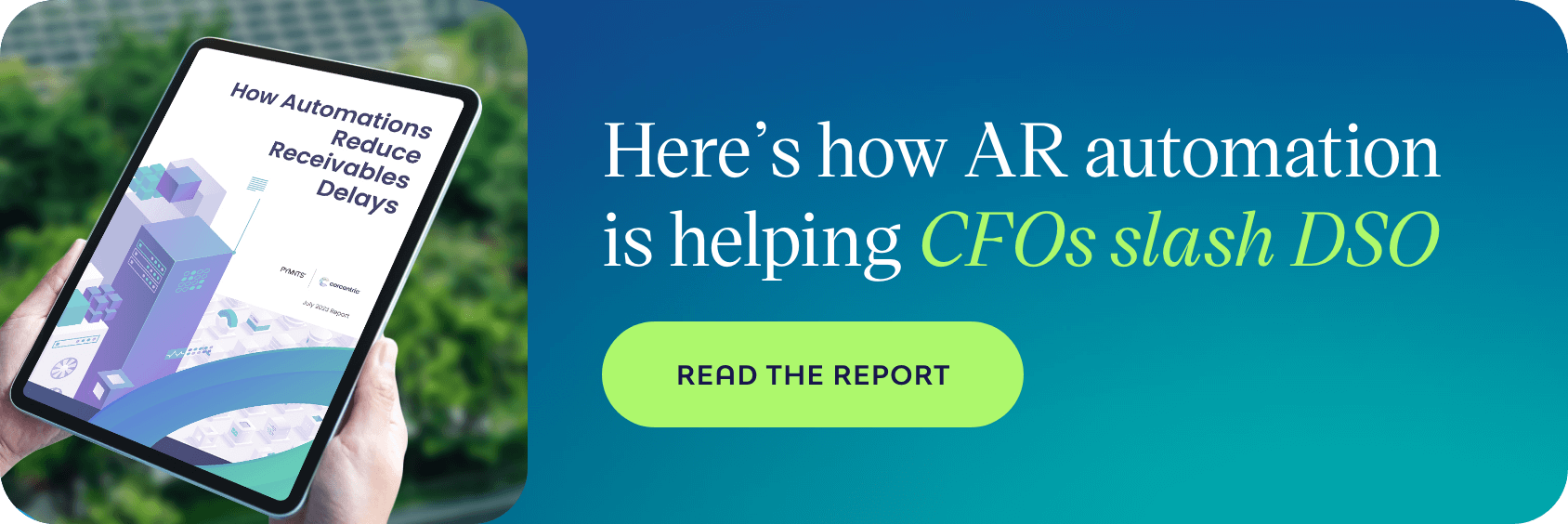10-Point Plan for Reducing Bad Debt, DBT, and DSO
Corcentric

Ask any CFO — why would a business not want to reduce bad debt, days beyond terms (DBT), and days sales outstanding (DSO)? These three metrics provide great insight into the financial health of a business, and reducing them improves liquidity through their impact on the balance sheet.
Benchmarking these three metrics helps you track improvements in the cash conversion cycle as changes are applied to liberate working capital from the accounts receivable (AR) ledger.
Accounts receivable and cash flow control
The impact of accounts receivable processes on how businesses bring their cash in cannot be overstated. From credit application to the collection process, AR departments have a unique level of influence over the factors that can negate cash flow problems.
The accounts receivable department first influences the process by assessing the creditworthiness of any new customer before allocating credit in line with company credit policy. Wrong calls at this stage can result in non-payment and write-offs when trying to bring the cash in.
AR departments need to be able to set credit terms that are realistic but supportive of the growth of new business. Above all, AR remains mindful of the fact they will need to collect payments from these customers within a specific number of days in the future.
A fine balance is struck in trying to support the sales process and build customer relationships while also being diligent in the allocation of credit to grow new business. These customer relationships are built and maintained through a good customer experience across the billing and collections process.
With this in mind, how can the AR process be refined and better supported to drive down bad debt, DBT, and DSO?
1. Streamline and automate AR processes
The right AR methodology can have a significant impact on cash flow. Streamlining AR processes can also save overheads and have an impact on your bottom line.
Automating aspects of the AR process, such as invoice creation and delivery, as well as streamlining the payment process for customers, can result in invoices reaching customers sooner, shortening the collection period.
Automated invoices bypass human error, leading to fewer queries and a shorter time to bring the cash in. Process improvements that streamline invoicing and payments will naturally result in lower DSO as more invoices are paid on time.
This is not a suggestion that the whole AR process should be automated, but automation can play an important role in reducing the manual workload that overburdens skilled AR staff. This can free up these valuable employees to redeploy their time to more profitable work.
2. Improve invoice delivery
Last year, 53% of B2B invoices across Western Europe were paid late (according to Atradius). It is unreasonable to assume these payment delays are entirely due to customers being unable, or unwilling, to pay within the agreed number of days. In fact, it has previously been estimated that around 20% of invoices are paid late due to problems with their content or delivery.
The shift towards electronic invoicing has already proven its ability to dramatically improve invoice delivery, creating more opportunities to confirm receipt and automating both delivery and payment processing.
The reality is, however, that the burden of “going digital” is sometimes passed on to suppliers as buyers ask for invoices to be manually uploaded or rekeyed into buyers’ accounts payable portals.
Businesses should look for ways to harness electronic or at least automated invoice delivery to reduce time, cost, and human error in the delivery process. The faster and more accurately invoices are delivered, the fewer barriers there are to prompt payment and reduced DSO.
3. Improve visibility of invoice delivery and payment status
Electronic invoicing provides a unique opportunity to improve visibility into invoice delivery, receipt, acknowledgment, and payment status. Knowing who has received and responded to invoices helps streamline the follow-up process and can even enable you to remind customers before their invoices are past due, helping drive down late payments and DSO.
Delivery reporting is possible for paper invoices if you select a reported/tracked delivery service. Some invoicing platforms even allow you to view the delivery status of electronic and paper invoices in the same way.
4. Encourage early payment
With the end goal of bringing cash in sooner, customers can be given incentives to pay sooner to reduce late payments.
However, different industries may have longer cash conversion cycles due to supply chain and production requirements. Consequently, it may not always be possible to encourage the desired reduction in the average number of days before payment, regardless of the incentive to do this.
Conversely, some businesses have tried to reduce their average DSO by agreeing to late payment penalties with new customers as part of their contractual terms. From a customer experience angle, it is better to incentivize than penalize, making it easier to sign new customers, too.
5. Automate the dunning process
Following improved delivery and payment status visibility, follow-up actions can be automated to ensure dunning letters are sent in time to have a meaningful impact on DSO.
Chasing customers for liabilities ahead of their due date, or even when past due, may not be ideal, but is preferable to escalating debt collection to a collection agency. Automating these communications, in line with payment history and credit risk, provides a relatively light touch but is an effective way to minimize late payers and invoices past due.
6. Scale with managed services
Managed services bring together people, processes, and technology as a cohesive solution to many different business procedures. Why should AR be any different?
Managed services enable you to work with solution experts to ensure best practices and minimize risks without the time and expense of having to develop these skills in-house.
Scale your accounts receivable processes up or down without the need to recruit, train, and manage extra staff or invest IT resources in technology development and integration. Achieve this flexibility without compromising customer experience throughout the invoicing and collections process.
Where possible, consider white glove services to support the care you put into your customer relationships. This is especially important with debt collection – don’t just hand it over to a collection agency with no vested interest in customer experience. Maintain the existing quality of your customer experience but offload mundane and repetitive processes to a managed services provider.
7. Detach payment terms from invoice settlement
A high DSO can indicate cash flow problems because it shows a large amount of money owed to your business. However, many businesses choose to reduce the risk to their financial health by using their AR ledger as an asset to secure finance. Invoice finance, such as invoice factoring, can provide businesses with immediate relief when financial statements show cash flow problems.
However, invoice factoring typically involves committing to a long-term involvement with the factoring provider (18 months or more) and may require new businesses to comply with more restrictive credit limits. Furthermore, factoring is normally quite visible to customers as being serviced by a third party. A third party may not treat your late-paying customers with the same degree of understanding and consideration as you would, given they have no vested interest in customer relationships beyond payment of each invoice.
Sales teams typically want to offer longer credit terms to win deals, but credit limits imposed by credit management may be seen as a roadblock to driving up the volume and value of credit sales.
To resolve this apparent conflict, many of our clients work with Corcentric Managed Accounts Receivable (Managed AR) to guarantee payment of invoices within an agreed timeframe. You no longer need to closely monitor payers to forecast cash inflows and reduce late payments. Extending your AR department with a managed service like Managed AR brings you the guaranteed business outcome of invoice payment on the agreed number of days after issue.
8. Fix your days sales outstanding
With Corcentric Managed AR, you can literally set the number of days you are willing to wait for invoice payments to be made. Some businesses start working with Corcentric to bring down DSO to just a few days initially, and some look to make more dramatic reductions. Every day of DSO reduction equates to the liberation of substantial working capital.
Sometimes, problems with payments may be confined to a specific and troublesome sub-ledger, which would be an ideal candidate to consider for the application of Corcentric Managed AR.
Corcentric Managed AR is not just a short-term fix; we can support you as a long-term partner to create ongoing DSO reductions and complete cash flow predictability. You can read about how we helped Daimler bring their DSO down from 37 days to just 15 days in our case study.
9. Protect your cash flow with a non-recourse agreement
Reducing DSO is one thing, but fixing DSO to a specific number of days and not having any recourse to pay if customers default on payments provides assurance in cash position in the longer term.
Invoice finance solutions, such as invoice factoring or invoice discounting, tend to have clauses where the financed client is liable for their customers’ invoice payments if they are not made within a given timeframe.
CFOs and other financial leaders need to have confidence that working capital liberated and then reinvested is for the long-term. By removing the risk of cash-flow uncertainty from AR with a non-recourse agreement, Corcentric absorbs the risk of non-payment as part of our service, protecting you from financial shocks further down the line.
10. Close the credit management cycle
Working with a service provider to handle invoicing and payments, as with Corcentric Managed AR, shouldn’t cut you off from the visibility of accounts and payment status. It’s important that you are able to stay informed via appropriate platforms so that your future credit decisions can take payment performance into account.
As a white glove solution, Corcentric Managed AR takes your existing best practice and applies this to handling disputes or payment anomalies so they are resolved quickly and amicably. However, the details of these exchanges will be preserved as a full audit trail and made available to inform future account decisions for the better.
Work with an experienced partner
Whether your business is ready to dive in and tackle bad debt, DBT, and DSO all at once, or more likely to take a measured approach, Corcentric can help. Through Corcentric Managed AR, and e-invoicing and payments automation, you can implement process improvements that will have an immediate and sustainable impact on improving cash flow and optimizing working capital management.
Read the How Managed Accounts Receivable Unlocks Working Capital whitepaper to explore how you can get paid faster, ensure cash flow certainty, and eliminate bad debt without negatively impacting customer experience or shortening their payment terms.

